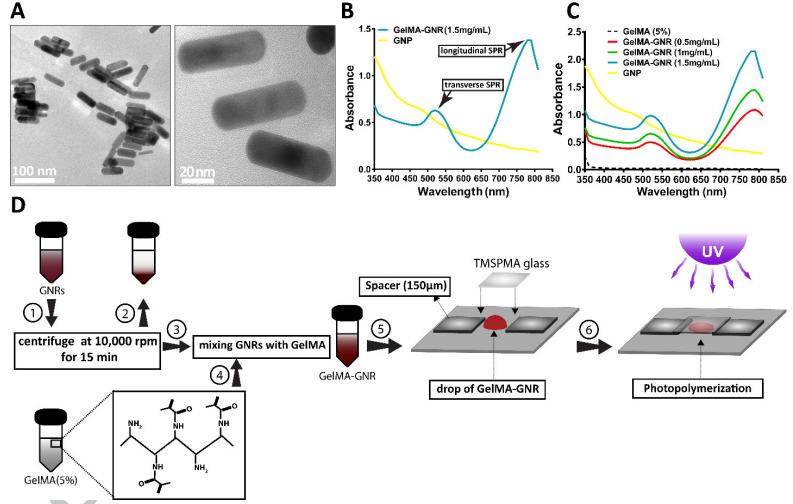Cardiac tissue engineering- -GelMA-GNR hydrogel

Gold nanorod-incorporated Gelatin-based Conductive Hydrogels for Engineering Cardiac Tissue Constructs
The development of advanced biomaterials is a critical step in enhancing the efficacy of strategies for tissue engineering against myocardial infarction. Further enhancement of specific properties of biomaterials, including conductivity, mechanical strength and structural integrity, is needed to promote cardiomyocyte function. In this work, we made a UV-cross-linked gold nanorods (GNR) -binding methacrylate gelatin (GelMA) hybrid hydrogel with enhanced material and biological properties that can be used for cardiac tissue engineering. The embedded GNR promotes the conductivity and mechanical stiffness of the hydrogel matrix. Cardiomyocytes inoculated on a GelMA-GNR hybrid hydrogel showed excellent cell retention, viability, and metabolic activity. Increased cell adhesion force causes an enrichment of locally organized F-actin fibers, leading to the formation of an integrated tissue layer on a hydrogel embedded with GNR. Immunostaining images of the integrin β -1 confirmed the improved cell-matrix interactions on the hybrid hydrogel. Notably, the uniform distribution of heart-specific markers (muscle-type α -actin and connexin 43) was observed on GelMA-GNR hydrogels as a function of the concentration of GNRs. Furthermore, GelMA-GNR hybrids also supported synchronous tissue level beating of cardiomyocytes. Similar observations were indicated by calcium transient assays that demonstrated the rhythmic contraction of cardiomyocytes on the GelMA-GNR hydrogel compared to pure GelMA. Thus, the findings of this study clearly demonstrate that functional cardiac patches with excellent electrical-and-mechanical properties can be developed using nanoengineered GelMA-GNR hybrid hydrogels.
+86-18915413828(WhatsApp&WeChat)
Previous: Cardiac tissue enginee
Next: BK Engineering Bacteri


